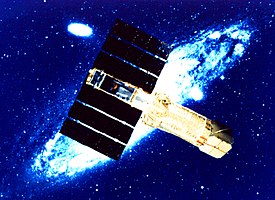Advanced Satellite for Cosmology and Astrophysics
 |
|||||||||
| Names | ASTRO-D, Asuka | ||||||||
|---|---|---|---|---|---|---|---|---|---|
| Mission type | X-ray observatory | ||||||||
| Operator | ISAS / NASA | ||||||||
| COSPAR ID | 1993-011A | ||||||||
| SATCAT no. | 22521 | ||||||||
| Website | http://heasarc.gsfc.nasa.gov/docs/asca/ | ||||||||
| Mission duration | Final: 8 years, 10 days | ||||||||
| Spacecraft properties | |||||||||
| Manufacturer | NEC | ||||||||
| Launch mass | 420 kg (930 lb) | ||||||||
| Dimensions | 4.7 m (15 ft) long | ||||||||
| Start of mission | |||||||||
| Launch date | 20 February 1993, 02:20 UTC | ||||||||
| Rocket | Mu-3SII 7 | ||||||||
| Launch site | Kagoshima Space Center, Japan | ||||||||
| Contractor | ISAS | ||||||||
| End of mission | |||||||||
| Disposal | deorbited | ||||||||
| Decay date | 2 March 2001, 14:20 UTC | ||||||||
| Orbital parameters | |||||||||
| Reference system | Geocentric | ||||||||
| Regime | Low Earth | ||||||||
| Eccentricity | 0.01 | ||||||||
| Perigee | 523.6 km (325.3 mi) | ||||||||
| Apogee | 615.3 km (382.3 mi) | ||||||||
| Inclination | 31.1° | ||||||||
| Period | 96.09 minutes | ||||||||
| Epoch | 20 February 1993 | ||||||||
| Main telescope | |||||||||
| Type | Wolter | ||||||||
| Diameter | 1.2 m (3.9 ft) | ||||||||
| Focal length | 3.5 m (11 ft) | ||||||||
| Collecting area | 1,300 cm2 (200 sq in) @ 1 kev 600 cm2 (93 sq in) @ 7 keV |
||||||||
| Wavelengths |
X-ray, SIS: 3–0.12 nm (0.4–10 keV) GIS: 1.8–0.12 nm (0.7–10 keV) |
||||||||
|
|||||||||
| Instruments | |
|---|---|
| XRT | X-ray Telescope |
| SIS | Solid-State Imaging Spectrometer |
| GIS | Gas Imaging Spectrometer |
The Advanced Satellite for Cosmology and Astrophysics (ASCA, formerly named ASTRO-D) was the fourth cosmic X-ray astronomy mission by JAXA, and the second for which the United States provided part of the scientific payload. The satellite was successfully launched on 20 February 1993. The first eight months of the ASCA mission were devoted to performance verification. Having established the quality of performance of all ASCA's instruments, the spacecraft provided science observations for the remainder of the mission. In this phase the observing program was open to astronomers based at Japanese and U.S. institutions, as well as those located in member states of the European Space Agency.
ASCA was the first X-ray astronomy mission to combine imaging capability with a broad pass band, good spectral resolution, and a large effective area. The mission also was the first satellite to use CCDs for X-ray astronomy. With these properties, the primary scientific purpose of ASCA is the X-ray spectroscopy of astrophysical plasmas, especially the analysis of discrete features such as emission lines and absorption edges.
ASCA carried four large-area X-ray telescopes. At the focus of two of the telescopes is a gas imaging spectrometer (GIS), while a solid-state imaging spectrometer (SIS) is at the focus of the other two. The GIS is a gas-imaging scintillation proportional counter and is based on the GSPC that flew on the second Japanese X-ray astronomy mission TENMA. The two identical charge-coupled device (CCD) cameras were provided for the two SISs by a hardware team from MIT, Osaka University and ISAS.
The ASCA was launched by ISAS (Institute of Space and Astronautical Sciences), Japan.
The sensitivity of ASCA's instruments allowed for the first detailed, broad-band spectra of distant quasars to be derived. In addition, ASCA's suite of instruments provided the best opportunity at the time for identifying the sources whose combined emission makes up the cosmic X-ray background.
...
Wikipedia
